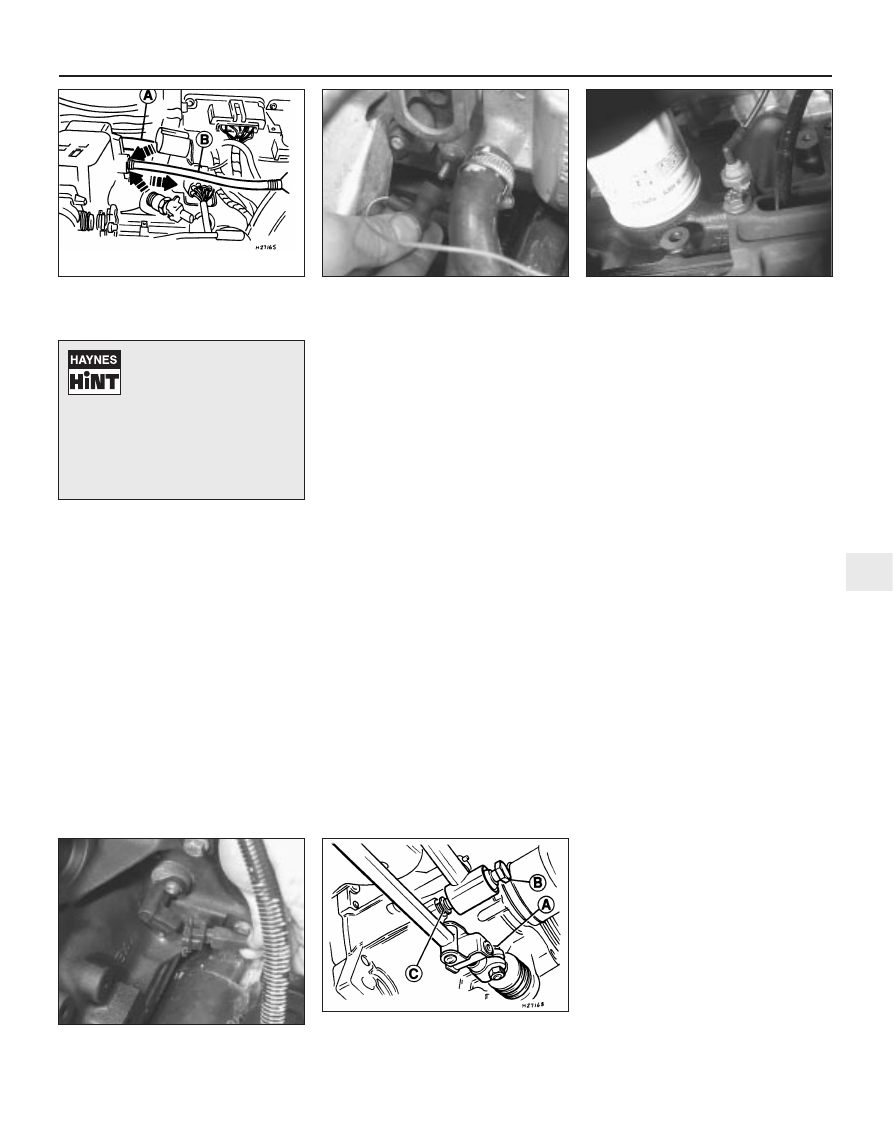Ford Fiesta (1989-1995). Instruction - part 19

7 Refer to the relevant Part of Chapter 4 for
details, and disconnect the accelerator cable
from the throttle linkage and support/adjuster
bracket. Where applicable, also disconnect
the choke cable. Position the cable(s) out of
the way.
8 On carburettor models, disconnect the fuel
supply hose from the fuel pump, and the
return hose from the carburettor.
9 On CFi models, detach the fuel hose at the
injector/pressure regulator unit, and the return
line, by compressing the couplings whilst
pulling the hoses free from their connections.
On EFi and SEFi models, unscrew the union
nut to detach the fuel line from the fuel rail;
release the retaining clip to detach the return
pipe from the pressure regulator. Plug the
exposed ends of the hoses and connections,
to prevent fuel spillage and the ingress of dirt.
Position the hoses out of the way.
10 Press the clamp ring inwards, and
simultaneously pull free the brake servo hose
from the inlet manifold. Position it out of the
way.
11 On CFi and EFi models, detach the
vacuum hose from the MAP sensor, and the
hose between the carbon canister and the fuel
injection unit (see illustration).
12 Note their connections and routings, and
detach the following wiring connections,
according to model (see illustrations):
a)
Coolant temperature sender unit.
b)
Oil pressure switch.
c)
E-DIS ignition coil unit. or distributor.
d)
Coolant temperature sensor.
e)
Cooling fan thermostatic switch.
f)
Carburettor.
g)
Earth lead (radio).
h)
Reversing light switch (from transmission).
i)
Crankshaft position sensor.
j)
Earth leads from the transmission and
engine.
13 Disconnect the wiring at the following
additional items specific to fuel injection
models only.
a)
Inlet air temperature sensor.
b)
Vehicle speed sensor.
c)
Throttle plate control motor (CFi
models).
d)
Throttle position sensor.
e)
Injector harness connector.
f)
Idle speed control valve (EFi and SEFi
models).
14 Unscrew the retaining bolt and detach the
bracket locating the wiring and coolant hoses
above the transmission.
15 Disconnect the speedometer drive cable
from the transmission.
16 On instruction transmission models,
disconnect the clutch cable from the release
lever at the transmission (see Chapter 6 for
details). Position the cable out of the way.
17 On vehicles fitted with the anti-lock
braking system, refer to Chapter 9 and release
the left-hand modulator from its mounting
bracket, without disconnecting the rigid brake
pipes or return hose. Tie the modulator
securely to the bulkhead.
18 Chock the rear wheels then jack up the
front of the car and support it on axle stands
(see “Jacking and Vehicle Support”). Allow
sufficient clearance under the vehicle to
withdraw the engine and transmission units
from under the front end.
19 On XR2i models, refer to Chapter 10 and
remove the front suspension crossmember.
20 Where applicable on catalytic converter-
equipped vehicles, release the multi-plug from
the bracket and disconnect the wiring
connector from the oxygen sensor in the
exhaust downpipe.
21 Undo the three retaining bolts, detach the
exhaust downpipe from the manifold, and
collect the gasket from the flange joint. Now
disconnect the exhaust downpipe from the
rest of the system, and remove it from the
vehicle.
22 Where fitted, undo the four retaining nuts
and two bolts securing the front part of the
exhaust heat shield to the floor, then remove
the heat shield.
23 Refer to Chapter 5A and remove the
alternator and starter motor. On models with
power steering, refer to Chapter 10 and
remove the power steering pump.
Instruction transmission models
24 On 4-speed models, select 2nd gear; on
5-speed models, select 4th gear, to assist in
correct adjustment of the gearchange during
reassembly. If it is likely that the gear lever will
be moved from this position before refitting,
mark the relative position of the transmission
shift rod and the selector shaft before
separating them. Undo the clamp bolt, and
then pull free and detach the shift rod from the
selector shaft (see illustration).
Engine removal and overhaul procedures 2D•9
4.12b . . . the oil pressure switch . . .
4.12a Disconnect the wiring at the
temperature gauge sender unit . . .
4.11 Vacuum hose to MAP sensor (A) and
brake servo (B)
4.24 Instruction transmission shift rod clamp
bolt (A), stabiliser-to-transmission bolt (B)
and washer (C)
4.12c . . . and the crankshaft position
sensor
2D
1595Ford Fiesta Remake
Whenever you disconnect
any vacuum lines, coolant or
emissions hoses, wiring
connectors and fuel lines,
always label them clearly, so that they
can be correctly reassembled. Masking
tape and/or a touch-up paint applicator
work well for marking items. Take
instant photos, or sketch the locations
of components and brackets.